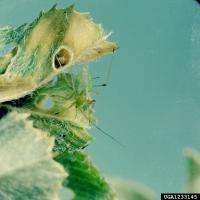Aphid's genome generates exciting questions

The genome of the pea aphid (Acyrthosiphon pisum), sequenced by the International Aphid Genomics Consortium, is published this week in the online open-access journal PLoS Biology. Scientists from more than 10 nations took part in the sequencing and analysis of the genome, whose publication in PLoS Biology is accompanied by related papers appearing in PLoS Genetics, Genome Biology, and a special issue of Insect Molecular Biology.
Aphids could be considered the "mosquitoes" of the plant world, depending on the "blood" of plants to survive. They live in symbiosis with bacteria that pass from one generation to the next, producing amino acids that are essential to the aphids.
"Because this is a different kind of insect - not a fruit fly, not a beetle, not a hymenoptera (butterfly and moth) - we are seeing things that people have not seen in other genome projects," project leader Stephen Richards said.
Princeton University's David Stern agreed with Richards that the aphid presents a special case. "Look at this little insect, sitting on a plant and sucking plant juices. You don't realize that it is involved in a historic battle with plants for access to their life blood. All its genes have evolved to allow it to exploit its feeding relationship."
"We found a lot of genes - 35,000 compared to 15,000 to 20,000 in other insects, and 25,000 in humans," said Richards. "Thus it seems that pea aphids have duplicated some of their genes," said Dr. Denis Tagu of the French National Institute for Agricultural Research.
What does this mean? It means that the pea aphid probably did a kind of 'back-up' of its genetic material. One hypothesis is that one copy of this back-up is kept unchanged and used for the functioning of the cells and the organism, and the second set can develop modifications by mutation.
"Most of the mutations are probably neutral or negative for the genes, with no effect on the biology of the organism. But some rare mutations might produce new functions for some of the genes that might help, in this case, the pea aphid adapt to its environment. Another possibility is that maybe aphids require extra copies of genes to regulate all parts of their complex life cycles," Stern said. "They have multiple forms to adapt to different environments. There are winged and wingless forms and some that produce asexually but give birth to live offspring."
"This genome has generated far more exciting questions than we could have anticipated. There is more mystery in this genome than anyone would have expected," he said.
Dr. Tagu said that sequencing the genome may give scientists tools they can use to control pests such as aphids. "It is similar to describing the anatomy of the human body, in the past. We are at the very beginning of using it to understand how these insects function and how they are adapted to feed from plants and provoke damage in agriculture. Understanding the molecular dialogue between bacterial and aphid genes could lead to the discovery of key regulatory mechanisms that can decrease the efficiency of the symbiosis and disrupt the aphid's impact on crops."
More information: The International Aphid Genomics Consortium (2010) Genome Sequence of the Pea Aphid Acyrthosiphon pisum. PLoS Biol 8(2): e1000313. doi:10.1371/ journal.pbio.1000313
Provided by Public Library of Science


















